Comprehensive U.K. Taxation Report: Self-Employed, Sole Trader, Corp
VerifiedAdded on 2020/03/16
|13
|4224
|41
Report
AI Summary
This report provides a comprehensive overview of U.K. taxation, addressing various aspects relevant to self-employed individuals, sole traders, and corporations. Part one focuses on the self-employed taxpayer, outlining registration requirements, responsibilities, VAT considerations, personal allowances, and National Insurance contributions. It also covers tax return and payment deadlines, along with potential liabilities and penalties for late filings. Part two compares sole traders with limited companies, highlighting key differences in employment status, profit extraction, tax-free benefits, borrowing, and tax on profits. The report also delves into corporation tax computation in part three, explaining the taxation of worldwide profits, adjustments for non-trading receipts, and the treatment of trading losses and capital losses. Finally, part four discusses R&D tax claims for Small and Medium Enterprises (SMEs), detailing the SME scheme and the Research and Development Expenditure Credit (RDEC) scheme, including eligibility criteria and benefits. The report is a valuable resource for understanding the U.K. tax system and its implications for different business structures.
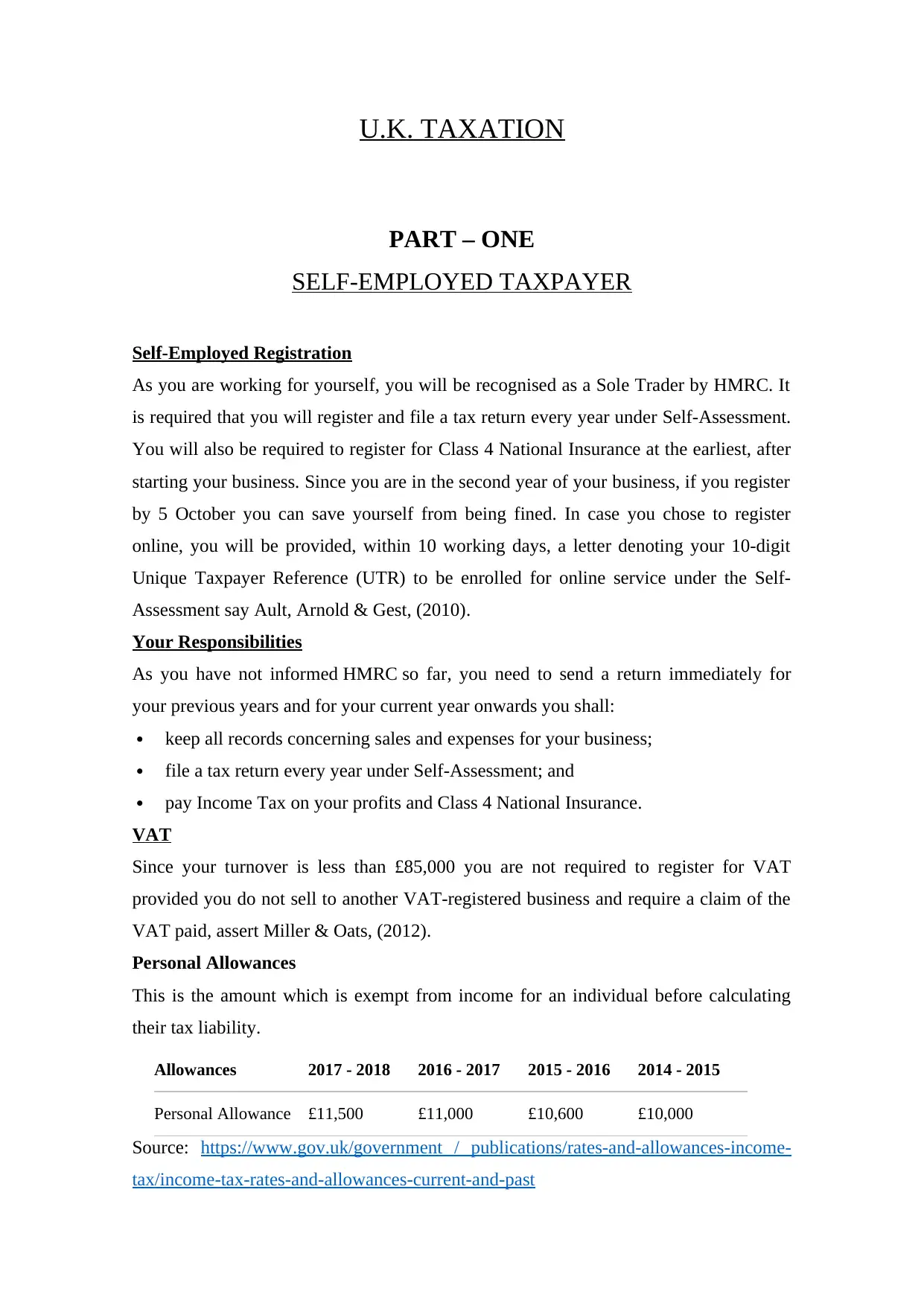
U.K. TAXATION
PART – ONE
SELF-EMPLOYED TAXPAYER
Self-Employed Registration
As you are working for yourself, you will be recognised as a Sole Trader by HMRC. It
is required that you will register and file a tax return every year under Self-Assessment.
You will also be required to register for Class 4 National Insurance at the earliest, after
starting your business. Since you are in the second year of your business, if you register
by 5 October you can save yourself from being fined. In case you chose to register
online, you will be provided, within 10 working days, a letter denoting your 10-digit
Unique Taxpayer Reference (UTR) to be enrolled for online service under the Self-
Assessment say Ault, Arnold & Gest, (2010).
Your Responsibilities
As you have not informed HMRC so far, you need to send a return immediately for
your previous years and for your current year onwards you shall:
keep all records concerning sales and expenses for your business;
file a tax return every year under Self-Assessment; and
pay Income Tax on your profits and Class 4 National Insurance.
VAT
Since your turnover is less than £85,000 you are not required to register for VAT
provided you do not sell to another VAT-registered business and require a claim of the
VAT paid, assert Miller & Oats, (2012).
Personal Allowances
This is the amount which is exempt from income for an individual before calculating
their tax liability.
Allowances 2017 - 2018 2016 - 2017 2015 - 2016 2014 - 2015
Personal Allowance £11,500 £11,000 £10,600 £10,000
Source: https://www.gov.uk/government / publications/rates-and-allowances-income-
tax/income-tax-rates-and-allowances-current-and-past
PART – ONE
SELF-EMPLOYED TAXPAYER
Self-Employed Registration
As you are working for yourself, you will be recognised as a Sole Trader by HMRC. It
is required that you will register and file a tax return every year under Self-Assessment.
You will also be required to register for Class 4 National Insurance at the earliest, after
starting your business. Since you are in the second year of your business, if you register
by 5 October you can save yourself from being fined. In case you chose to register
online, you will be provided, within 10 working days, a letter denoting your 10-digit
Unique Taxpayer Reference (UTR) to be enrolled for online service under the Self-
Assessment say Ault, Arnold & Gest, (2010).
Your Responsibilities
As you have not informed HMRC so far, you need to send a return immediately for
your previous years and for your current year onwards you shall:
keep all records concerning sales and expenses for your business;
file a tax return every year under Self-Assessment; and
pay Income Tax on your profits and Class 4 National Insurance.
VAT
Since your turnover is less than £85,000 you are not required to register for VAT
provided you do not sell to another VAT-registered business and require a claim of the
VAT paid, assert Miller & Oats, (2012).
Personal Allowances
This is the amount which is exempt from income for an individual before calculating
their tax liability.
Allowances 2017 - 2018 2016 - 2017 2015 - 2016 2014 - 2015
Personal Allowance £11,500 £11,000 £10,600 £10,000
Source: https://www.gov.uk/government / publications/rates-and-allowances-income-
tax/income-tax-rates-and-allowances-current-and-past
Paraphrase This Document
Need a fresh take? Get an instant paraphrase of this document with our AI Paraphraser
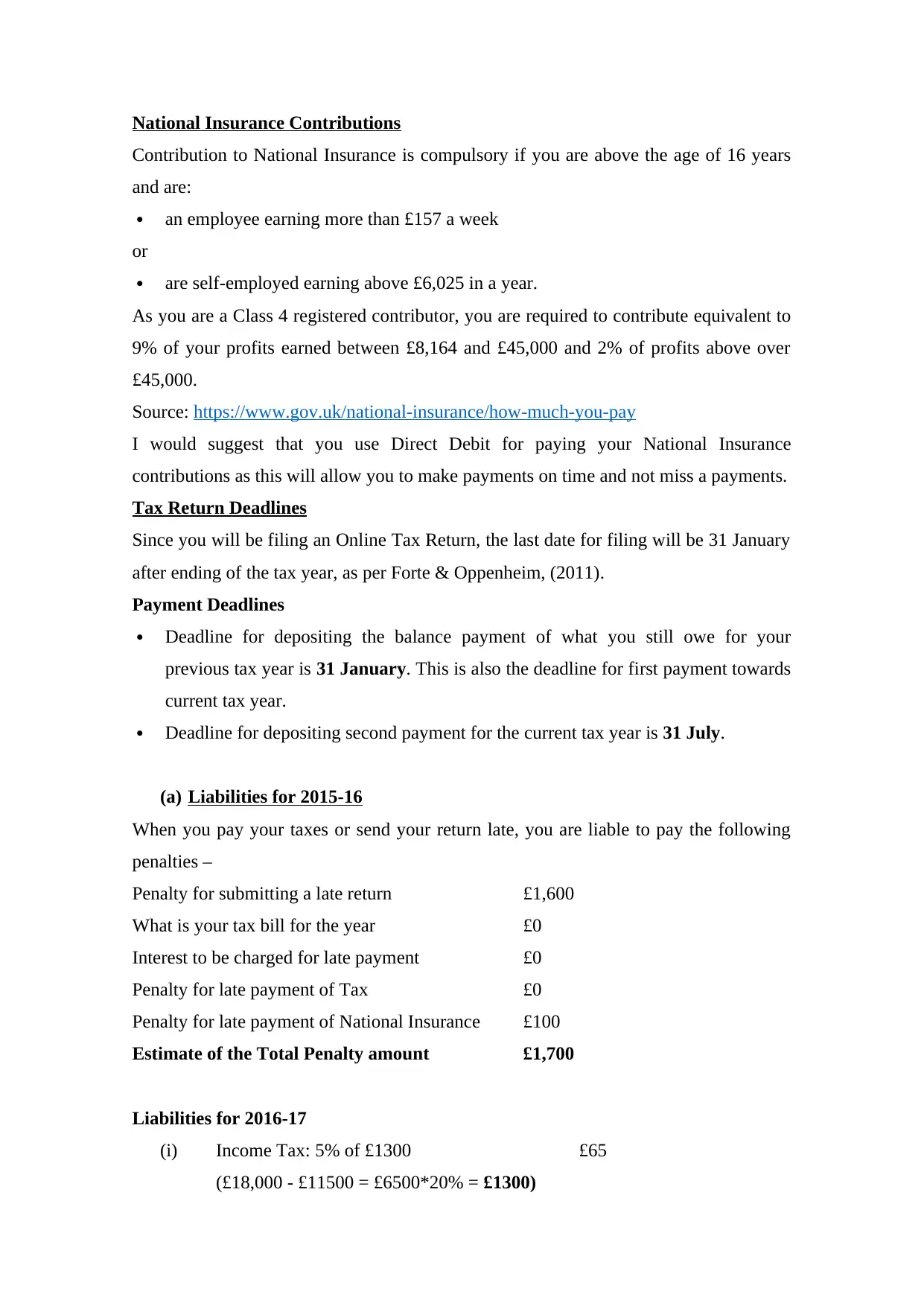
National Insurance Contributions
Contribution to National Insurance is compulsory if you are above the age of 16 years
and are:
an employee earning more than £157 a week
or
are self-employed earning above £6,025 in a year.
As you are a Class 4 registered contributor, you are required to contribute equivalent to
9% of your profits earned between £8,164 and £45,000 and 2% of profits above over
£45,000.
Source: https://www.gov.uk/national-insurance/how-much-you-pay
I would suggest that you use Direct Debit for paying your National Insurance
contributions as this will allow you to make payments on time and not miss a payments.
Tax Return Deadlines
Since you will be filing an Online Tax Return, the last date for filing will be 31 January
after ending of the tax year, as per Forte & Oppenheim, (2011).
Payment Deadlines
Deadline for depositing the balance payment of what you still owe for your
previous tax year is 31 January. This is also the deadline for first payment towards
current tax year.
Deadline for depositing second payment for the current tax year is 31 July.
(a) Liabilities for 2015-16
When you pay your taxes or send your return late, you are liable to pay the following
penalties –
Penalty for submitting a late return £1,600
What is your tax bill for the year £0
Interest to be charged for late payment £0
Penalty for late payment of Tax £0
Penalty for late payment of National Insurance £100
Estimate of the Total Penalty amount £1,700
Liabilities for 2016-17
(i) Income Tax: 5% of £1300 £65
(£18,000 - £11500 = £6500*20% = £1300)
Contribution to National Insurance is compulsory if you are above the age of 16 years
and are:
an employee earning more than £157 a week
or
are self-employed earning above £6,025 in a year.
As you are a Class 4 registered contributor, you are required to contribute equivalent to
9% of your profits earned between £8,164 and £45,000 and 2% of profits above over
£45,000.
Source: https://www.gov.uk/national-insurance/how-much-you-pay
I would suggest that you use Direct Debit for paying your National Insurance
contributions as this will allow you to make payments on time and not miss a payments.
Tax Return Deadlines
Since you will be filing an Online Tax Return, the last date for filing will be 31 January
after ending of the tax year, as per Forte & Oppenheim, (2011).
Payment Deadlines
Deadline for depositing the balance payment of what you still owe for your
previous tax year is 31 January. This is also the deadline for first payment towards
current tax year.
Deadline for depositing second payment for the current tax year is 31 July.
(a) Liabilities for 2015-16
When you pay your taxes or send your return late, you are liable to pay the following
penalties –
Penalty for submitting a late return £1,600
What is your tax bill for the year £0
Interest to be charged for late payment £0
Penalty for late payment of Tax £0
Penalty for late payment of National Insurance £100
Estimate of the Total Penalty amount £1,700
Liabilities for 2016-17
(i) Income Tax: 5% of £1300 £65
(£18,000 - £11500 = £6500*20% = £1300)
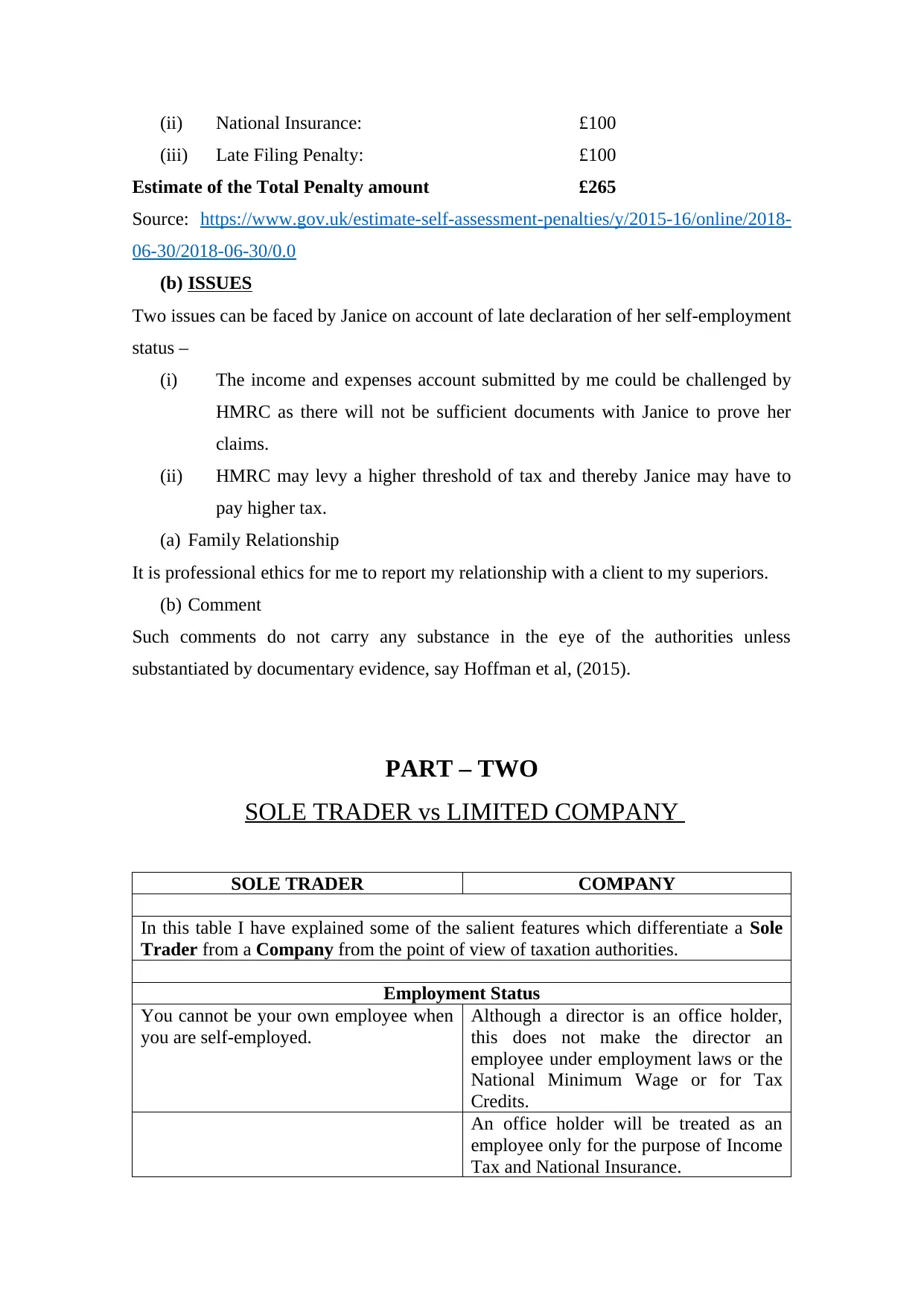
(ii) National Insurance: £100
(iii) Late Filing Penalty: £100
Estimate of the Total Penalty amount £265
Source: https://www.gov.uk/estimate-self-assessment-penalties/y/2015-16/online/2018-
06-30/2018-06-30/0.0
(b) ISSUES
Two issues can be faced by Janice on account of late declaration of her self-employment
status –
(i) The income and expenses account submitted by me could be challenged by
HMRC as there will not be sufficient documents with Janice to prove her
claims.
(ii) HMRC may levy a higher threshold of tax and thereby Janice may have to
pay higher tax.
(a) Family Relationship
It is professional ethics for me to report my relationship with a client to my superiors.
(b) Comment
Such comments do not carry any substance in the eye of the authorities unless
substantiated by documentary evidence, say Hoffman et al, (2015).
PART – TWO
SOLE TRADER vs LIMITED COMPANY
SOLE TRADER COMPANY
In this table I have explained some of the salient features which differentiate a Sole
Trader from a Company from the point of view of taxation authorities.
Employment Status
You cannot be your own employee when
you are self-employed.
Although a director is an office holder,
this does not make the director an
employee under employment laws or the
National Minimum Wage or for Tax
Credits.
An office holder will be treated as an
employee only for the purpose of Income
Tax and National Insurance.
(iii) Late Filing Penalty: £100
Estimate of the Total Penalty amount £265
Source: https://www.gov.uk/estimate-self-assessment-penalties/y/2015-16/online/2018-
06-30/2018-06-30/0.0
(b) ISSUES
Two issues can be faced by Janice on account of late declaration of her self-employment
status –
(i) The income and expenses account submitted by me could be challenged by
HMRC as there will not be sufficient documents with Janice to prove her
claims.
(ii) HMRC may levy a higher threshold of tax and thereby Janice may have to
pay higher tax.
(a) Family Relationship
It is professional ethics for me to report my relationship with a client to my superiors.
(b) Comment
Such comments do not carry any substance in the eye of the authorities unless
substantiated by documentary evidence, say Hoffman et al, (2015).
PART – TWO
SOLE TRADER vs LIMITED COMPANY
SOLE TRADER COMPANY
In this table I have explained some of the salient features which differentiate a Sole
Trader from a Company from the point of view of taxation authorities.
Employment Status
You cannot be your own employee when
you are self-employed.
Although a director is an office holder,
this does not make the director an
employee under employment laws or the
National Minimum Wage or for Tax
Credits.
An office holder will be treated as an
employee only for the purpose of Income
Tax and National Insurance.
⊘ This is a preview!⊘
Do you want full access?
Subscribe today to unlock all pages.

Trusted by 1+ million students worldwide
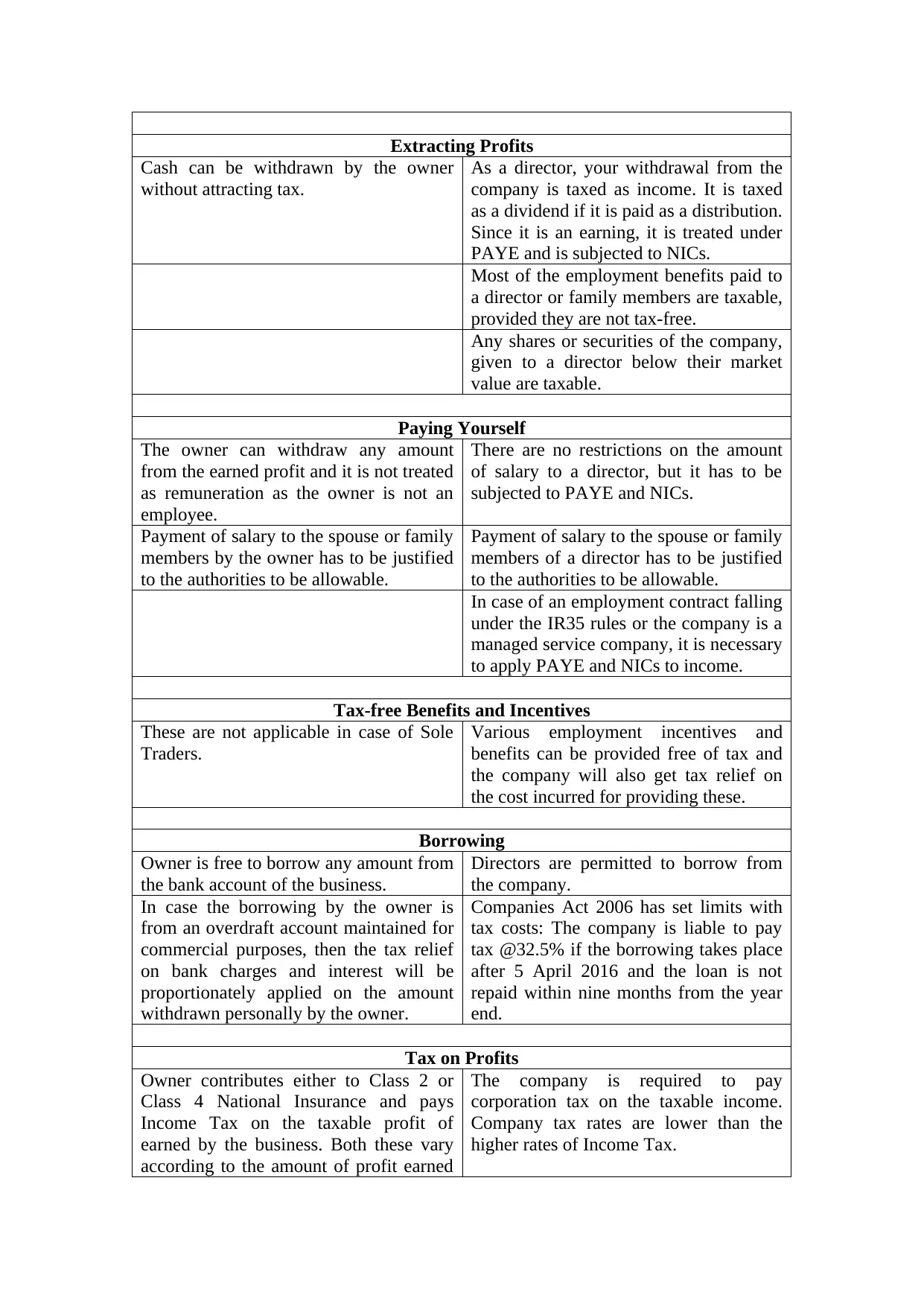
Extracting Profits
Cash can be withdrawn by the owner
without attracting tax.
As a director, your withdrawal from the
company is taxed as income. It is taxed
as a dividend if it is paid as a distribution.
Since it is an earning, it is treated under
PAYE and is subjected to NICs.
Most of the employment benefits paid to
a director or family members are taxable,
provided they are not tax-free.
Any shares or securities of the company,
given to a director below their market
value are taxable.
Paying Yourself
The owner can withdraw any amount
from the earned profit and it is not treated
as remuneration as the owner is not an
employee.
There are no restrictions on the amount
of salary to a director, but it has to be
subjected to PAYE and NICs.
Payment of salary to the spouse or family
members by the owner has to be justified
to the authorities to be allowable.
Payment of salary to the spouse or family
members of a director has to be justified
to the authorities to be allowable.
In case of an employment contract falling
under the IR35 rules or the company is a
managed service company, it is necessary
to apply PAYE and NICs to income.
Tax-free Benefits and Incentives
These are not applicable in case of Sole
Traders.
Various employment incentives and
benefits can be provided free of tax and
the company will also get tax relief on
the cost incurred for providing these.
Borrowing
Owner is free to borrow any amount from
the bank account of the business.
Directors are permitted to borrow from
the company.
In case the borrowing by the owner is
from an overdraft account maintained for
commercial purposes, then the tax relief
on bank charges and interest will be
proportionately applied on the amount
withdrawn personally by the owner.
Companies Act 2006 has set limits with
tax costs: The company is liable to pay
tax @32.5% if the borrowing takes place
after 5 April 2016 and the loan is not
repaid within nine months from the year
end.
Tax on Profits
Owner contributes either to Class 2 or
Class 4 National Insurance and pays
Income Tax on the taxable profit of
earned by the business. Both these vary
according to the amount of profit earned
The company is required to pay
corporation tax on the taxable income.
Company tax rates are lower than the
higher rates of Income Tax.
Cash can be withdrawn by the owner
without attracting tax.
As a director, your withdrawal from the
company is taxed as income. It is taxed
as a dividend if it is paid as a distribution.
Since it is an earning, it is treated under
PAYE and is subjected to NICs.
Most of the employment benefits paid to
a director or family members are taxable,
provided they are not tax-free.
Any shares or securities of the company,
given to a director below their market
value are taxable.
Paying Yourself
The owner can withdraw any amount
from the earned profit and it is not treated
as remuneration as the owner is not an
employee.
There are no restrictions on the amount
of salary to a director, but it has to be
subjected to PAYE and NICs.
Payment of salary to the spouse or family
members by the owner has to be justified
to the authorities to be allowable.
Payment of salary to the spouse or family
members of a director has to be justified
to the authorities to be allowable.
In case of an employment contract falling
under the IR35 rules or the company is a
managed service company, it is necessary
to apply PAYE and NICs to income.
Tax-free Benefits and Incentives
These are not applicable in case of Sole
Traders.
Various employment incentives and
benefits can be provided free of tax and
the company will also get tax relief on
the cost incurred for providing these.
Borrowing
Owner is free to borrow any amount from
the bank account of the business.
Directors are permitted to borrow from
the company.
In case the borrowing by the owner is
from an overdraft account maintained for
commercial purposes, then the tax relief
on bank charges and interest will be
proportionately applied on the amount
withdrawn personally by the owner.
Companies Act 2006 has set limits with
tax costs: The company is liable to pay
tax @32.5% if the borrowing takes place
after 5 April 2016 and the loan is not
repaid within nine months from the year
end.
Tax on Profits
Owner contributes either to Class 2 or
Class 4 National Insurance and pays
Income Tax on the taxable profit of
earned by the business. Both these vary
according to the amount of profit earned
The company is required to pay
corporation tax on the taxable income.
Company tax rates are lower than the
higher rates of Income Tax.
Paraphrase This Document
Need a fresh take? Get an instant paraphrase of this document with our AI Paraphraser
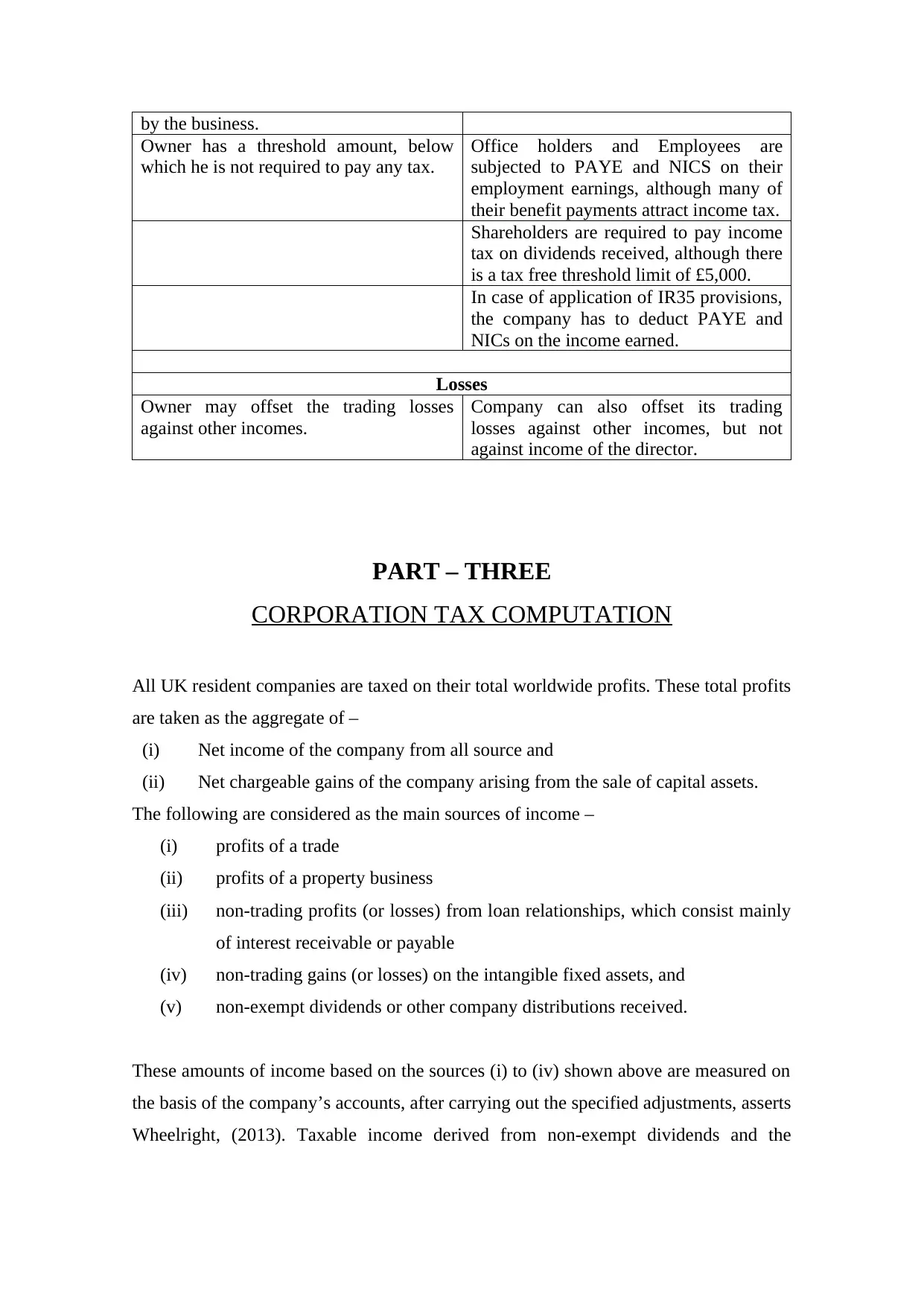
by the business.
Owner has a threshold amount, below
which he is not required to pay any tax.
Office holders and Employees are
subjected to PAYE and NICS on their
employment earnings, although many of
their benefit payments attract income tax.
Shareholders are required to pay income
tax on dividends received, although there
is a tax free threshold limit of £5,000.
In case of application of IR35 provisions,
the company has to deduct PAYE and
NICs on the income earned.
Losses
Owner may offset the trading losses
against other incomes.
Company can also offset its trading
losses against other incomes, but not
against income of the director.
PART – THREE
CORPORATION TAX COMPUTATION
All UK resident companies are taxed on their total worldwide profits. These total profits
are taken as the aggregate of –
(i) Net income of the company from all source and
(ii) Net chargeable gains of the company arising from the sale of capital assets.
The following are considered as the main sources of income –
(i) profits of a trade
(ii) profits of a property business
(iii) non-trading profits (or losses) from loan relationships, which consist mainly
of interest receivable or payable
(iv) non-trading gains (or losses) on the intangible fixed assets, and
(v) non-exempt dividends or other company distributions received.
These amounts of income based on the sources (i) to (iv) shown above are measured on
the basis of the company’s accounts, after carrying out the specified adjustments, asserts
Wheelright, (2013). Taxable income derived from non-exempt dividends and the
Owner has a threshold amount, below
which he is not required to pay any tax.
Office holders and Employees are
subjected to PAYE and NICS on their
employment earnings, although many of
their benefit payments attract income tax.
Shareholders are required to pay income
tax on dividends received, although there
is a tax free threshold limit of £5,000.
In case of application of IR35 provisions,
the company has to deduct PAYE and
NICs on the income earned.
Losses
Owner may offset the trading losses
against other incomes.
Company can also offset its trading
losses against other incomes, but not
against income of the director.
PART – THREE
CORPORATION TAX COMPUTATION
All UK resident companies are taxed on their total worldwide profits. These total profits
are taken as the aggregate of –
(i) Net income of the company from all source and
(ii) Net chargeable gains of the company arising from the sale of capital assets.
The following are considered as the main sources of income –
(i) profits of a trade
(ii) profits of a property business
(iii) non-trading profits (or losses) from loan relationships, which consist mainly
of interest receivable or payable
(iv) non-trading gains (or losses) on the intangible fixed assets, and
(v) non-exempt dividends or other company distributions received.
These amounts of income based on the sources (i) to (iv) shown above are measured on
the basis of the company’s accounts, after carrying out the specified adjustments, asserts
Wheelright, (2013). Taxable income derived from non-exempt dividends and the
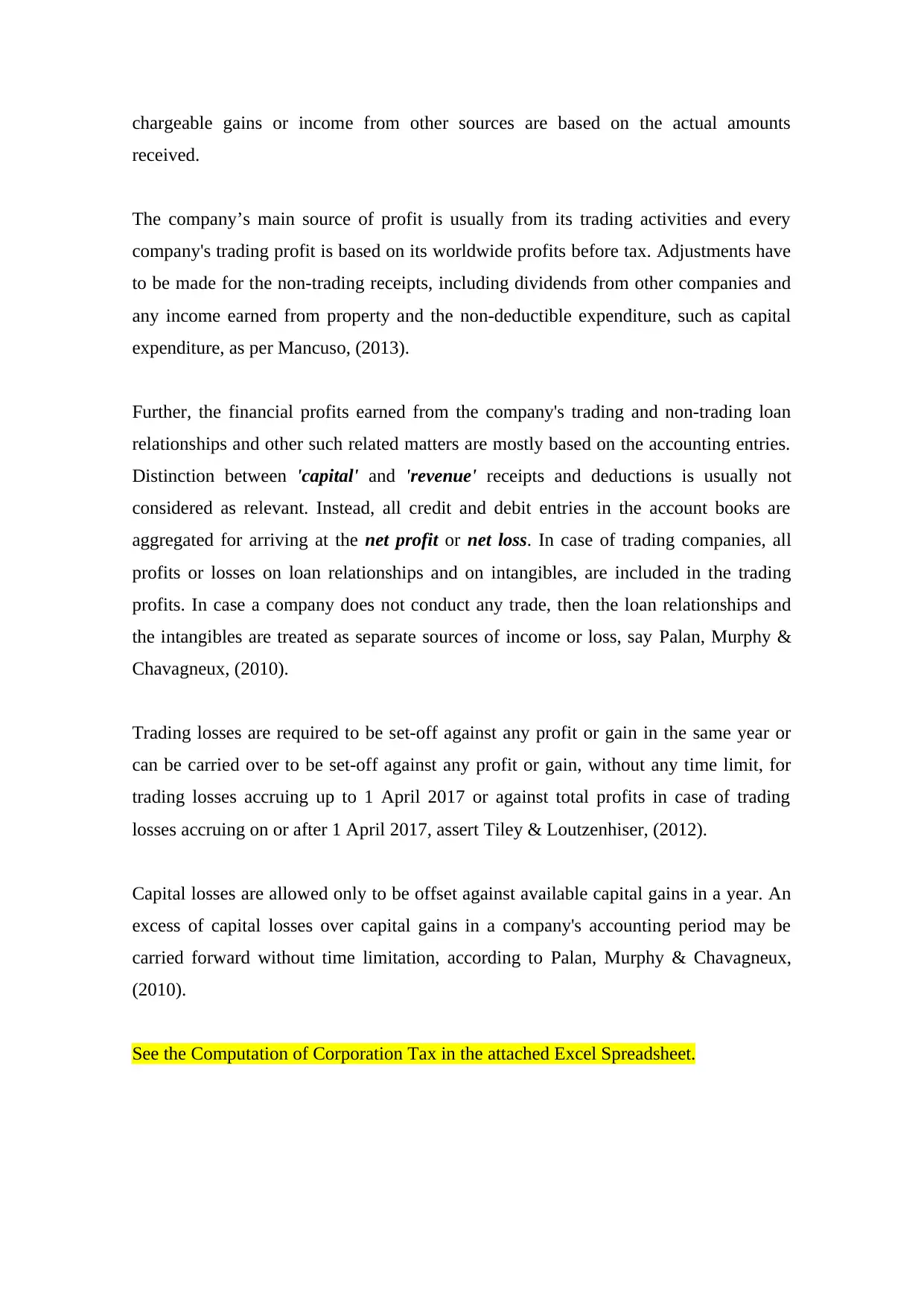
chargeable gains or income from other sources are based on the actual amounts
received.
The company’s main source of profit is usually from its trading activities and every
company's trading profit is based on its worldwide profits before tax. Adjustments have
to be made for the non-trading receipts, including dividends from other companies and
any income earned from property and the non-deductible expenditure, such as capital
expenditure, as per Mancuso, (2013).
Further, the financial profits earned from the company's trading and non-trading loan
relationships and other such related matters are mostly based on the accounting entries.
Distinction between 'capital' and 'revenue' receipts and deductions is usually not
considered as relevant. Instead, all credit and debit entries in the account books are
aggregated for arriving at the net profit or net loss. In case of trading companies, all
profits or losses on loan relationships and on intangibles, are included in the trading
profits. In case a company does not conduct any trade, then the loan relationships and
the intangibles are treated as separate sources of income or loss, say Palan, Murphy &
Chavagneux, (2010).
Trading losses are required to be set-off against any profit or gain in the same year or
can be carried over to be set-off against any profit or gain, without any time limit, for
trading losses accruing up to 1 April 2017 or against total profits in case of trading
losses accruing on or after 1 April 2017, assert Tiley & Loutzenhiser, (2012).
Capital losses are allowed only to be offset against available capital gains in a year. An
excess of capital losses over capital gains in a company's accounting period may be
carried forward without time limitation, according to Palan, Murphy & Chavagneux,
(2010).
See the Computation of Corporation Tax in the attached Excel Spreadsheet.
received.
The company’s main source of profit is usually from its trading activities and every
company's trading profit is based on its worldwide profits before tax. Adjustments have
to be made for the non-trading receipts, including dividends from other companies and
any income earned from property and the non-deductible expenditure, such as capital
expenditure, as per Mancuso, (2013).
Further, the financial profits earned from the company's trading and non-trading loan
relationships and other such related matters are mostly based on the accounting entries.
Distinction between 'capital' and 'revenue' receipts and deductions is usually not
considered as relevant. Instead, all credit and debit entries in the account books are
aggregated for arriving at the net profit or net loss. In case of trading companies, all
profits or losses on loan relationships and on intangibles, are included in the trading
profits. In case a company does not conduct any trade, then the loan relationships and
the intangibles are treated as separate sources of income or loss, say Palan, Murphy &
Chavagneux, (2010).
Trading losses are required to be set-off against any profit or gain in the same year or
can be carried over to be set-off against any profit or gain, without any time limit, for
trading losses accruing up to 1 April 2017 or against total profits in case of trading
losses accruing on or after 1 April 2017, assert Tiley & Loutzenhiser, (2012).
Capital losses are allowed only to be offset against available capital gains in a year. An
excess of capital losses over capital gains in a company's accounting period may be
carried forward without time limitation, according to Palan, Murphy & Chavagneux,
(2010).
See the Computation of Corporation Tax in the attached Excel Spreadsheet.
⊘ This is a preview!⊘
Do you want full access?
Subscribe today to unlock all pages.

Trusted by 1+ million students worldwide
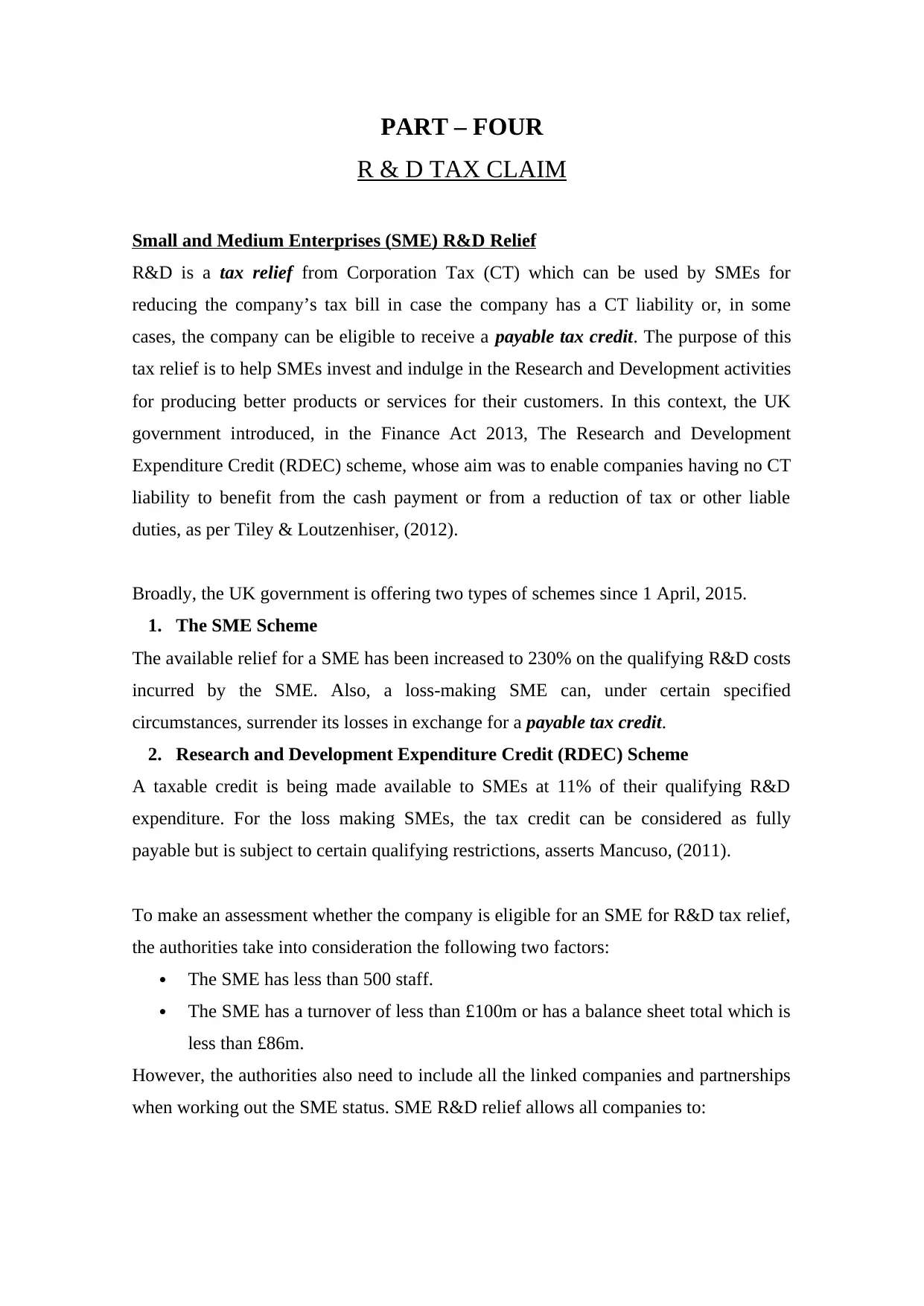
PART – FOUR
R & D TAX CLAIM
Small and Medium Enterprises (SME) R&D Relief
R&D is a tax relief from Corporation Tax (CT) which can be used by SMEs for
reducing the company’s tax bill in case the company has a CT liability or, in some
cases, the company can be eligible to receive a payable tax credit. The purpose of this
tax relief is to help SMEs invest and indulge in the Research and Development activities
for producing better products or services for their customers. In this context, the UK
government introduced, in the Finance Act 2013, The Research and Development
Expenditure Credit (RDEC) scheme, whose aim was to enable companies having no CT
liability to benefit from the cash payment or from a reduction of tax or other liable
duties, as per Tiley & Loutzenhiser, (2012).
Broadly, the UK government is offering two types of schemes since 1 April, 2015.
1. The SME Scheme
The available relief for a SME has been increased to 230% on the qualifying R&D costs
incurred by the SME. Also, a loss-making SME can, under certain specified
circumstances, surrender its losses in exchange for a payable tax credit.
2. Research and Development Expenditure Credit (RDEC) Scheme
A taxable credit is being made available to SMEs at 11% of their qualifying R&D
expenditure. For the loss making SMEs, the tax credit can be considered as fully
payable but is subject to certain qualifying restrictions, asserts Mancuso, (2011).
To make an assessment whether the company is eligible for an SME for R&D tax relief,
the authorities take into consideration the following two factors:
The SME has less than 500 staff.
The SME has a turnover of less than £100m or has a balance sheet total which is
less than £86m.
However, the authorities also need to include all the linked companies and partnerships
when working out the SME status. SME R&D relief allows all companies to:
R & D TAX CLAIM
Small and Medium Enterprises (SME) R&D Relief
R&D is a tax relief from Corporation Tax (CT) which can be used by SMEs for
reducing the company’s tax bill in case the company has a CT liability or, in some
cases, the company can be eligible to receive a payable tax credit. The purpose of this
tax relief is to help SMEs invest and indulge in the Research and Development activities
for producing better products or services for their customers. In this context, the UK
government introduced, in the Finance Act 2013, The Research and Development
Expenditure Credit (RDEC) scheme, whose aim was to enable companies having no CT
liability to benefit from the cash payment or from a reduction of tax or other liable
duties, as per Tiley & Loutzenhiser, (2012).
Broadly, the UK government is offering two types of schemes since 1 April, 2015.
1. The SME Scheme
The available relief for a SME has been increased to 230% on the qualifying R&D costs
incurred by the SME. Also, a loss-making SME can, under certain specified
circumstances, surrender its losses in exchange for a payable tax credit.
2. Research and Development Expenditure Credit (RDEC) Scheme
A taxable credit is being made available to SMEs at 11% of their qualifying R&D
expenditure. For the loss making SMEs, the tax credit can be considered as fully
payable but is subject to certain qualifying restrictions, asserts Mancuso, (2011).
To make an assessment whether the company is eligible for an SME for R&D tax relief,
the authorities take into consideration the following two factors:
The SME has less than 500 staff.
The SME has a turnover of less than £100m or has a balance sheet total which is
less than £86m.
However, the authorities also need to include all the linked companies and partnerships
when working out the SME status. SME R&D relief allows all companies to:
Paraphrase This Document
Need a fresh take? Get an instant paraphrase of this document with our AI Paraphraser
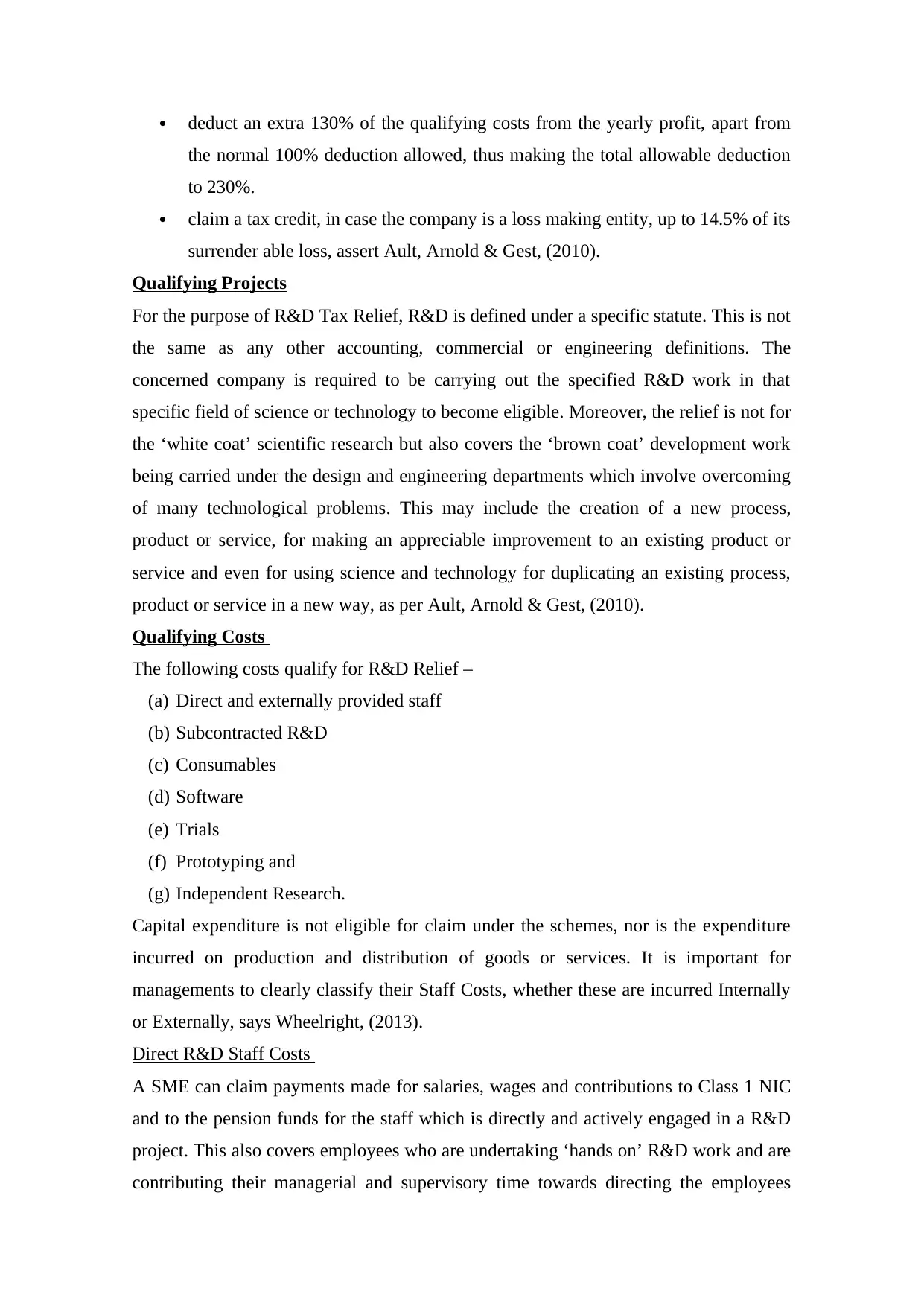
deduct an extra 130% of the qualifying costs from the yearly profit, apart from
the normal 100% deduction allowed, thus making the total allowable deduction
to 230%.
claim a tax credit, in case the company is a loss making entity, up to 14.5% of its
surrender able loss, assert Ault, Arnold & Gest, (2010).
Qualifying Projects
For the purpose of R&D Tax Relief, R&D is defined under a specific statute. This is not
the same as any other accounting, commercial or engineering definitions. The
concerned company is required to be carrying out the specified R&D work in that
specific field of science or technology to become eligible. Moreover, the relief is not for
the ‘white coat’ scientific research but also covers the ‘brown coat’ development work
being carried under the design and engineering departments which involve overcoming
of many technological problems. This may include the creation of a new process,
product or service, for making an appreciable improvement to an existing product or
service and even for using science and technology for duplicating an existing process,
product or service in a new way, as per Ault, Arnold & Gest, (2010).
Qualifying Costs
The following costs qualify for R&D Relief –
(a) Direct and externally provided staff
(b) Subcontracted R&D
(c) Consumables
(d) Software
(e) Trials
(f) Prototyping and
(g) Independent Research.
Capital expenditure is not eligible for claim under the schemes, nor is the expenditure
incurred on production and distribution of goods or services. It is important for
managements to clearly classify their Staff Costs, whether these are incurred Internally
or Externally, says Wheelright, (2013).
Direct R&D Staff Costs
A SME can claim payments made for salaries, wages and contributions to Class 1 NIC
and to the pension funds for the staff which is directly and actively engaged in a R&D
project. This also covers employees who are undertaking ‘hands on’ R&D work and are
contributing their managerial and supervisory time towards directing the employees
the normal 100% deduction allowed, thus making the total allowable deduction
to 230%.
claim a tax credit, in case the company is a loss making entity, up to 14.5% of its
surrender able loss, assert Ault, Arnold & Gest, (2010).
Qualifying Projects
For the purpose of R&D Tax Relief, R&D is defined under a specific statute. This is not
the same as any other accounting, commercial or engineering definitions. The
concerned company is required to be carrying out the specified R&D work in that
specific field of science or technology to become eligible. Moreover, the relief is not for
the ‘white coat’ scientific research but also covers the ‘brown coat’ development work
being carried under the design and engineering departments which involve overcoming
of many technological problems. This may include the creation of a new process,
product or service, for making an appreciable improvement to an existing product or
service and even for using science and technology for duplicating an existing process,
product or service in a new way, as per Ault, Arnold & Gest, (2010).
Qualifying Costs
The following costs qualify for R&D Relief –
(a) Direct and externally provided staff
(b) Subcontracted R&D
(c) Consumables
(d) Software
(e) Trials
(f) Prototyping and
(g) Independent Research.
Capital expenditure is not eligible for claim under the schemes, nor is the expenditure
incurred on production and distribution of goods or services. It is important for
managements to clearly classify their Staff Costs, whether these are incurred Internally
or Externally, says Wheelright, (2013).
Direct R&D Staff Costs
A SME can claim payments made for salaries, wages and contributions to Class 1 NIC
and to the pension funds for the staff which is directly and actively engaged in a R&D
project. This also covers employees who are undertaking ‘hands on’ R&D work and are
contributing their managerial and supervisory time towards directing the employees

involved in the activities. Also, all support staff costs, including those of the clerical or
administrative staff, may not be treated to qualify unless these relate to the qualifying
indirect activities. Such activities include the clerical, administrative, maintenance and
security work.
Externally provided R&D staff
These comprise of the costs paid to any external agency for maintaining staff which is
directly and actively engaged in the concerned R&D project and these are not
employees or subcontractors hired by the SME. Relief can be availed on 65% of these
payments to the external agency. However, special rules will apply if the SME and the
external agency are connected or elect to be connected, as per Forte & Oppenheim,
(2011).
How to calculate your claim
As an illustration, I am presenting, in three stages, a demo of how to make a claim.
1. Work out your allowable expenditure
Total Costs Reported by the SME Costs Allowable Amount in £
80% of R&D Staff Costs of
£150,000 related to R&D Project
80% of £150,000 120,000
20% of Managerial Cost of
£100,000 related to R&D Project
20% of £100,000 20,000
25% of Heat and Light Costs of
£5000 related to R&D Project
25% of £5,000 1,250
Disposable Laboratory Equipment 100% of £200 200
£80,000 Subcontractor payment
related to R&D Project
65% of £80,000 52,000
£70,000 External Agency payment
related to R&D Project
65% of £70,000 45,500
TOTAL 238,950
In this demo, I have shown that the total expenditure qualifying for relief is £238,950.
2. Turning the qualifying expenditure into R&D Tax Relief for Sugar Icing
Ltd.
The total qualifying cost in case of Sugar Icing is £140,000. Multiply this by 130%,
making it to £182,000. Sugar Icing as an SME, is allowed the original £140,000 (100%)
+ £182,000 (130%) as the enhanced amount for relief. Thus, Sugar Icing is eligible for a
total R&D tax relief of £322,000.
3. Put the R&D tax relief into the right box on the company tax return
administrative staff, may not be treated to qualify unless these relate to the qualifying
indirect activities. Such activities include the clerical, administrative, maintenance and
security work.
Externally provided R&D staff
These comprise of the costs paid to any external agency for maintaining staff which is
directly and actively engaged in the concerned R&D project and these are not
employees or subcontractors hired by the SME. Relief can be availed on 65% of these
payments to the external agency. However, special rules will apply if the SME and the
external agency are connected or elect to be connected, as per Forte & Oppenheim,
(2011).
How to calculate your claim
As an illustration, I am presenting, in three stages, a demo of how to make a claim.
1. Work out your allowable expenditure
Total Costs Reported by the SME Costs Allowable Amount in £
80% of R&D Staff Costs of
£150,000 related to R&D Project
80% of £150,000 120,000
20% of Managerial Cost of
£100,000 related to R&D Project
20% of £100,000 20,000
25% of Heat and Light Costs of
£5000 related to R&D Project
25% of £5,000 1,250
Disposable Laboratory Equipment 100% of £200 200
£80,000 Subcontractor payment
related to R&D Project
65% of £80,000 52,000
£70,000 External Agency payment
related to R&D Project
65% of £70,000 45,500
TOTAL 238,950
In this demo, I have shown that the total expenditure qualifying for relief is £238,950.
2. Turning the qualifying expenditure into R&D Tax Relief for Sugar Icing
Ltd.
The total qualifying cost in case of Sugar Icing is £140,000. Multiply this by 130%,
making it to £182,000. Sugar Icing as an SME, is allowed the original £140,000 (100%)
+ £182,000 (130%) as the enhanced amount for relief. Thus, Sugar Icing is eligible for a
total R&D tax relief of £322,000.
3. Put the R&D tax relief into the right box on the company tax return
⊘ This is a preview!⊘
Do you want full access?
Subscribe today to unlock all pages.

Trusted by 1+ million students worldwide
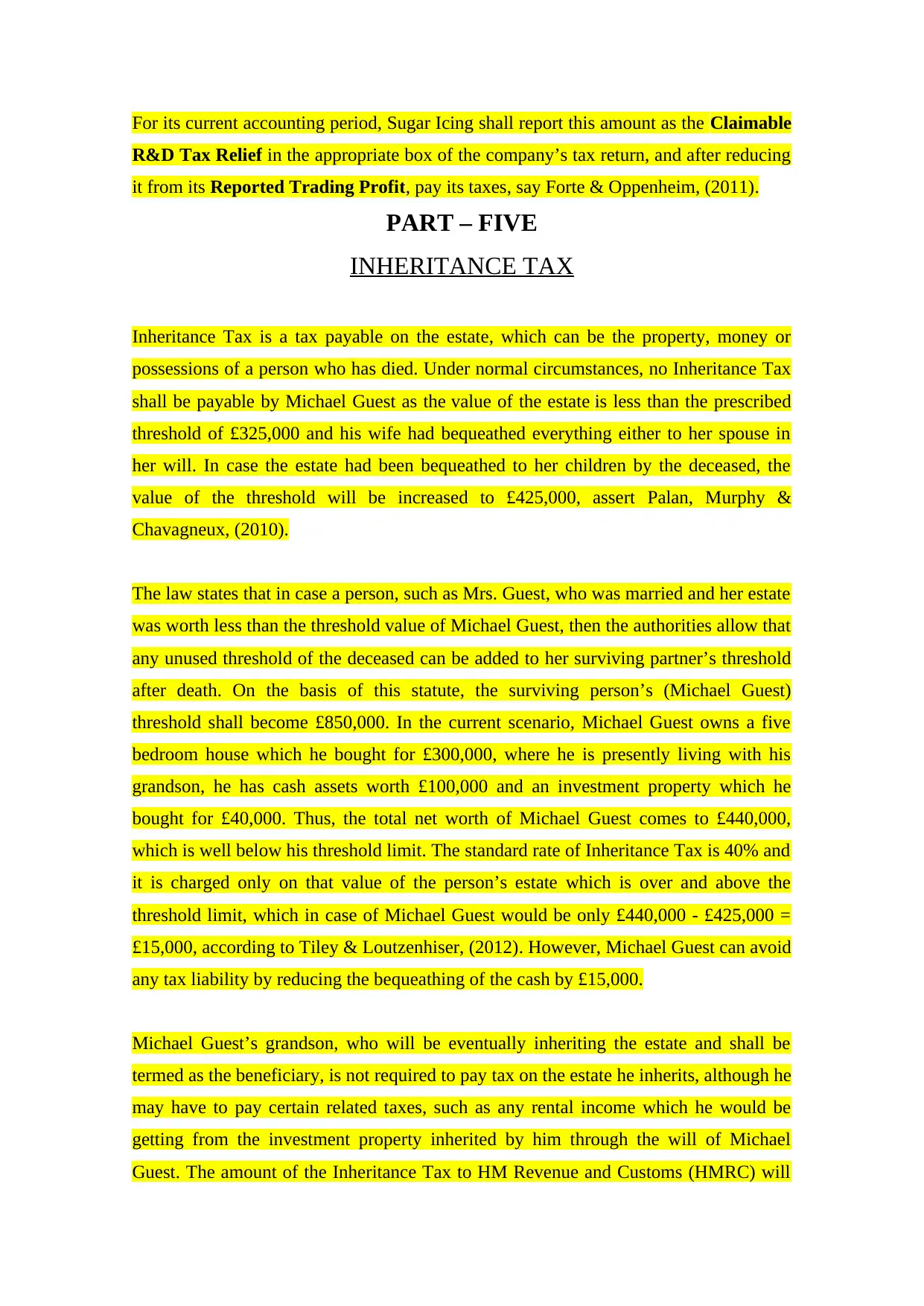
For its current accounting period, Sugar Icing shall report this amount as the Claimable
R&D Tax Relief in the appropriate box of the company’s tax return, and after reducing
it from its Reported Trading Profit, pay its taxes, say Forte & Oppenheim, (2011).
PART – FIVE
INHERITANCE TAX
Inheritance Tax is a tax payable on the estate, which can be the property, money or
possessions of a person who has died. Under normal circumstances, no Inheritance Tax
shall be payable by Michael Guest as the value of the estate is less than the prescribed
threshold of £325,000 and his wife had bequeathed everything either to her spouse in
her will. In case the estate had been bequeathed to her children by the deceased, the
value of the threshold will be increased to £425,000, assert Palan, Murphy &
Chavagneux, (2010).
The law states that in case a person, such as Mrs. Guest, who was married and her estate
was worth less than the threshold value of Michael Guest, then the authorities allow that
any unused threshold of the deceased can be added to her surviving partner’s threshold
after death. On the basis of this statute, the surviving person’s (Michael Guest)
threshold shall become £850,000. In the current scenario, Michael Guest owns a five
bedroom house which he bought for £300,000, where he is presently living with his
grandson, he has cash assets worth £100,000 and an investment property which he
bought for £40,000. Thus, the total net worth of Michael Guest comes to £440,000,
which is well below his threshold limit. The standard rate of Inheritance Tax is 40% and
it is charged only on that value of the person’s estate which is over and above the
threshold limit, which in case of Michael Guest would be only £440,000 - £425,000 =
£15,000, according to Tiley & Loutzenhiser, (2012). However, Michael Guest can avoid
any tax liability by reducing the bequeathing of the cash by £15,000.
Michael Guest’s grandson, who will be eventually inheriting the estate and shall be
termed as the beneficiary, is not required to pay tax on the estate he inherits, although he
may have to pay certain related taxes, such as any rental income which he would be
getting from the investment property inherited by him through the will of Michael
Guest. The amount of the Inheritance Tax to HM Revenue and Customs (HMRC) will
R&D Tax Relief in the appropriate box of the company’s tax return, and after reducing
it from its Reported Trading Profit, pay its taxes, say Forte & Oppenheim, (2011).
PART – FIVE
INHERITANCE TAX
Inheritance Tax is a tax payable on the estate, which can be the property, money or
possessions of a person who has died. Under normal circumstances, no Inheritance Tax
shall be payable by Michael Guest as the value of the estate is less than the prescribed
threshold of £325,000 and his wife had bequeathed everything either to her spouse in
her will. In case the estate had been bequeathed to her children by the deceased, the
value of the threshold will be increased to £425,000, assert Palan, Murphy &
Chavagneux, (2010).
The law states that in case a person, such as Mrs. Guest, who was married and her estate
was worth less than the threshold value of Michael Guest, then the authorities allow that
any unused threshold of the deceased can be added to her surviving partner’s threshold
after death. On the basis of this statute, the surviving person’s (Michael Guest)
threshold shall become £850,000. In the current scenario, Michael Guest owns a five
bedroom house which he bought for £300,000, where he is presently living with his
grandson, he has cash assets worth £100,000 and an investment property which he
bought for £40,000. Thus, the total net worth of Michael Guest comes to £440,000,
which is well below his threshold limit. The standard rate of Inheritance Tax is 40% and
it is charged only on that value of the person’s estate which is over and above the
threshold limit, which in case of Michael Guest would be only £440,000 - £425,000 =
£15,000, according to Tiley & Loutzenhiser, (2012). However, Michael Guest can avoid
any tax liability by reducing the bequeathing of the cash by £15,000.
Michael Guest’s grandson, who will be eventually inheriting the estate and shall be
termed as the beneficiary, is not required to pay tax on the estate he inherits, although he
may have to pay certain related taxes, such as any rental income which he would be
getting from the investment property inherited by him through the will of Michael
Guest. The amount of the Inheritance Tax to HM Revenue and Customs (HMRC) will
Paraphrase This Document
Need a fresh take? Get an instant paraphrase of this document with our AI Paraphraser
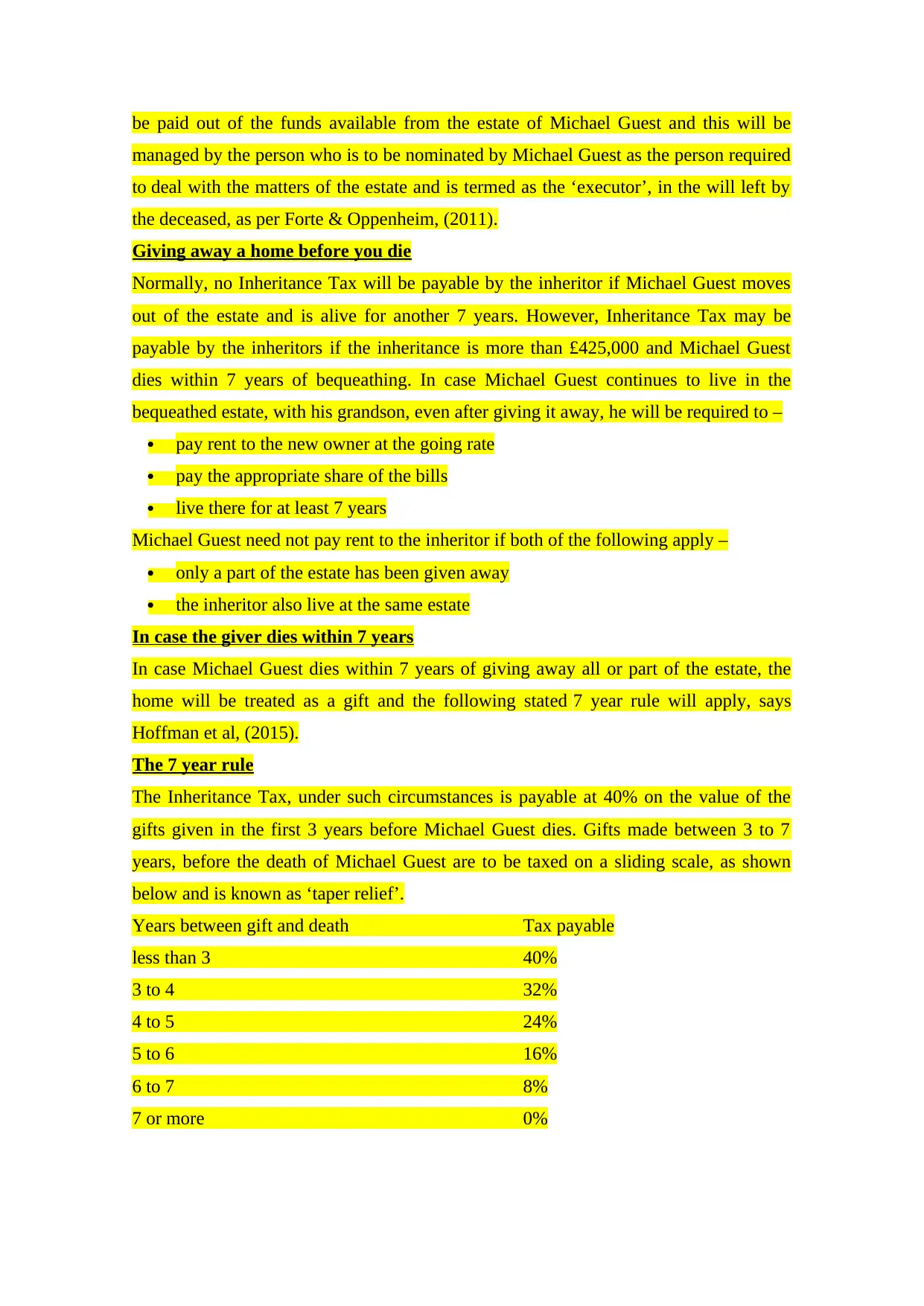
be paid out of the funds available from the estate of Michael Guest and this will be
managed by the person who is to be nominated by Michael Guest as the person required
to deal with the matters of the estate and is termed as the ‘executor’, in the will left by
the deceased, as per Forte & Oppenheim, (2011).
Giving away a home before you die
Normally, no Inheritance Tax will be payable by the inheritor if Michael Guest moves
out of the estate and is alive for another 7 years. However, Inheritance Tax may be
payable by the inheritors if the inheritance is more than £425,000 and Michael Guest
dies within 7 years of bequeathing. In case Michael Guest continues to live in the
bequeathed estate, with his grandson, even after giving it away, he will be required to –
pay rent to the new owner at the going rate
pay the appropriate share of the bills
live there for at least 7 years
Michael Guest need not pay rent to the inheritor if both of the following apply –
only a part of the estate has been given away
the inheritor also live at the same estate
In case the giver dies within 7 years
In case Michael Guest dies within 7 years of giving away all or part of the estate, the
home will be treated as a gift and the following stated 7 year rule will apply, says
Hoffman et al, (2015).
The 7 year rule
The Inheritance Tax, under such circumstances is payable at 40% on the value of the
gifts given in the first 3 years before Michael Guest dies. Gifts made between 3 to 7
years, before the death of Michael Guest are to be taxed on a sliding scale, as shown
below and is known as ‘taper relief’.
Years between gift and death Tax payable
less than 3 40%
3 to 4 32%
4 to 5 24%
5 to 6 16%
6 to 7 8%
7 or more 0%
managed by the person who is to be nominated by Michael Guest as the person required
to deal with the matters of the estate and is termed as the ‘executor’, in the will left by
the deceased, as per Forte & Oppenheim, (2011).
Giving away a home before you die
Normally, no Inheritance Tax will be payable by the inheritor if Michael Guest moves
out of the estate and is alive for another 7 years. However, Inheritance Tax may be
payable by the inheritors if the inheritance is more than £425,000 and Michael Guest
dies within 7 years of bequeathing. In case Michael Guest continues to live in the
bequeathed estate, with his grandson, even after giving it away, he will be required to –
pay rent to the new owner at the going rate
pay the appropriate share of the bills
live there for at least 7 years
Michael Guest need not pay rent to the inheritor if both of the following apply –
only a part of the estate has been given away
the inheritor also live at the same estate
In case the giver dies within 7 years
In case Michael Guest dies within 7 years of giving away all or part of the estate, the
home will be treated as a gift and the following stated 7 year rule will apply, says
Hoffman et al, (2015).
The 7 year rule
The Inheritance Tax, under such circumstances is payable at 40% on the value of the
gifts given in the first 3 years before Michael Guest dies. Gifts made between 3 to 7
years, before the death of Michael Guest are to be taxed on a sliding scale, as shown
below and is known as ‘taper relief’.
Years between gift and death Tax payable
less than 3 40%
3 to 4 32%
4 to 5 24%
5 to 6 16%
6 to 7 8%
7 or more 0%
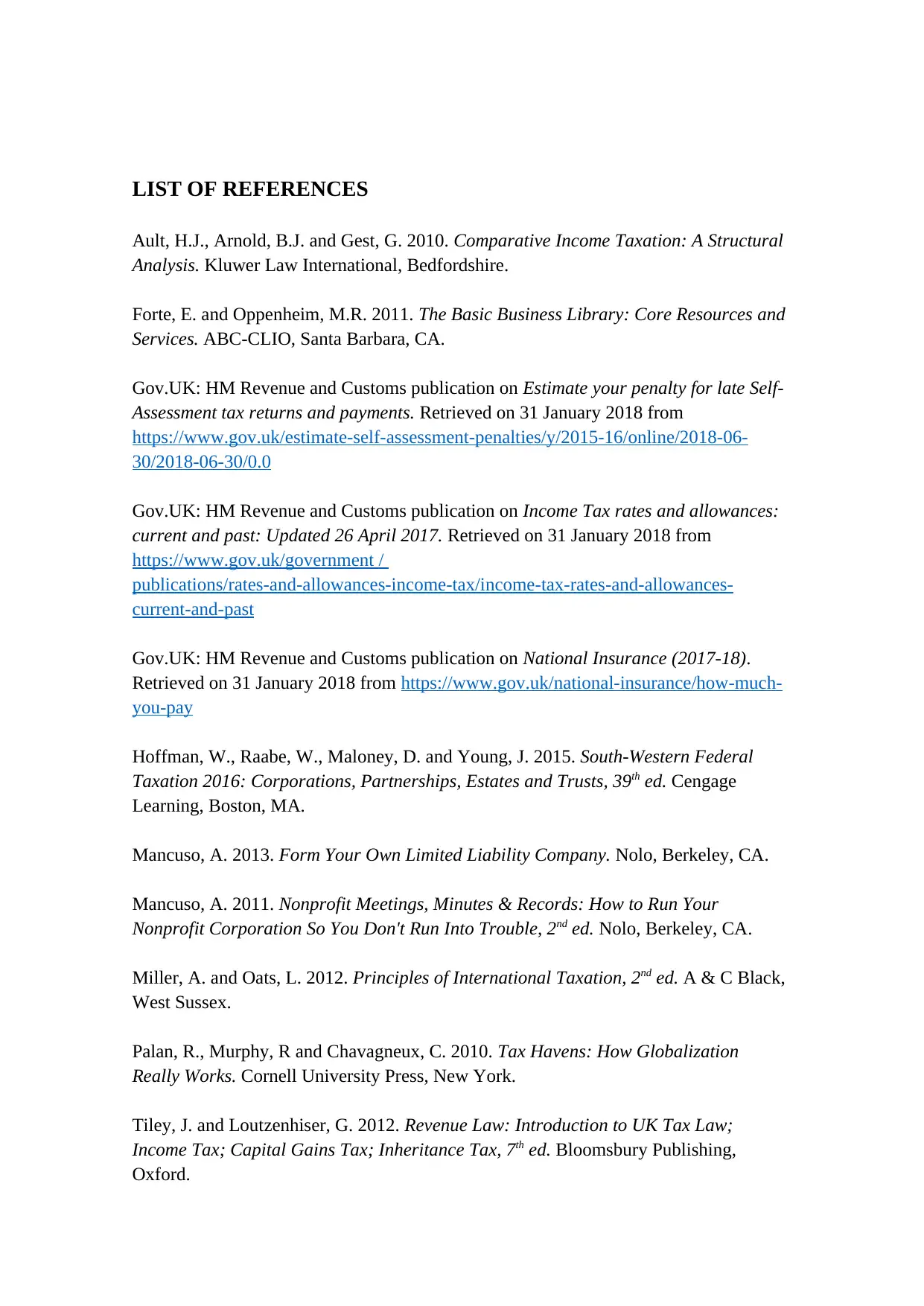
LIST OF REFERENCES
Ault, H.J., Arnold, B.J. and Gest, G. 2010. Comparative Income Taxation: A Structural
Analysis. Kluwer Law International, Bedfordshire.
Forte, E. and Oppenheim, M.R. 2011. The Basic Business Library: Core Resources and
Services. ABC-CLIO, Santa Barbara, CA.
Gov.UK: HM Revenue and Customs publication on Estimate your penalty for late Self-
Assessment tax returns and payments. Retrieved on 31 January 2018 from
https://www.gov.uk/estimate-self-assessment-penalties/y/2015-16/online/2018-06-
30/2018-06-30/0.0
Gov.UK: HM Revenue and Customs publication on Income Tax rates and allowances:
current and past: Updated 26 April 2017. Retrieved on 31 January 2018 from
https://www.gov.uk/government /
publications/rates-and-allowances-income-tax/income-tax-rates-and-allowances-
current-and-past
Gov.UK: HM Revenue and Customs publication on National Insurance (2017-18).
Retrieved on 31 January 2018 from https://www.gov.uk/national-insurance/how-much-
you-pay
Hoffman, W., Raabe, W., Maloney, D. and Young, J. 2015. South-Western Federal
Taxation 2016: Corporations, Partnerships, Estates and Trusts, 39th ed. Cengage
Learning, Boston, MA.
Mancuso, A. 2013. Form Your Own Limited Liability Company. Nolo, Berkeley, CA.
Mancuso, A. 2011. Nonprofit Meetings, Minutes & Records: How to Run Your
Nonprofit Corporation So You Don't Run Into Trouble, 2nd ed. Nolo, Berkeley, CA.
Miller, A. and Oats, L. 2012. Principles of International Taxation, 2nd ed. A & C Black,
West Sussex.
Palan, R., Murphy, R and Chavagneux, C. 2010. Tax Havens: How Globalization
Really Works. Cornell University Press, New York.
Tiley, J. and Loutzenhiser, G. 2012. Revenue Law: Introduction to UK Tax Law;
Income Tax; Capital Gains Tax; Inheritance Tax, 7th ed. Bloomsbury Publishing,
Oxford.
Ault, H.J., Arnold, B.J. and Gest, G. 2010. Comparative Income Taxation: A Structural
Analysis. Kluwer Law International, Bedfordshire.
Forte, E. and Oppenheim, M.R. 2011. The Basic Business Library: Core Resources and
Services. ABC-CLIO, Santa Barbara, CA.
Gov.UK: HM Revenue and Customs publication on Estimate your penalty for late Self-
Assessment tax returns and payments. Retrieved on 31 January 2018 from
https://www.gov.uk/estimate-self-assessment-penalties/y/2015-16/online/2018-06-
30/2018-06-30/0.0
Gov.UK: HM Revenue and Customs publication on Income Tax rates and allowances:
current and past: Updated 26 April 2017. Retrieved on 31 January 2018 from
https://www.gov.uk/government /
publications/rates-and-allowances-income-tax/income-tax-rates-and-allowances-
current-and-past
Gov.UK: HM Revenue and Customs publication on National Insurance (2017-18).
Retrieved on 31 January 2018 from https://www.gov.uk/national-insurance/how-much-
you-pay
Hoffman, W., Raabe, W., Maloney, D. and Young, J. 2015. South-Western Federal
Taxation 2016: Corporations, Partnerships, Estates and Trusts, 39th ed. Cengage
Learning, Boston, MA.
Mancuso, A. 2013. Form Your Own Limited Liability Company. Nolo, Berkeley, CA.
Mancuso, A. 2011. Nonprofit Meetings, Minutes & Records: How to Run Your
Nonprofit Corporation So You Don't Run Into Trouble, 2nd ed. Nolo, Berkeley, CA.
Miller, A. and Oats, L. 2012. Principles of International Taxation, 2nd ed. A & C Black,
West Sussex.
Palan, R., Murphy, R and Chavagneux, C. 2010. Tax Havens: How Globalization
Really Works. Cornell University Press, New York.
Tiley, J. and Loutzenhiser, G. 2012. Revenue Law: Introduction to UK Tax Law;
Income Tax; Capital Gains Tax; Inheritance Tax, 7th ed. Bloomsbury Publishing,
Oxford.
⊘ This is a preview!⊘
Do you want full access?
Subscribe today to unlock all pages.

Trusted by 1+ million students worldwide
1 out of 13
Related Documents
Your All-in-One AI-Powered Toolkit for Academic Success.
+13062052269
info@desklib.com
Available 24*7 on WhatsApp / Email
![[object Object]](/_next/static/media/star-bottom.7253800d.svg)
Unlock your academic potential
Copyright © 2020–2025 A2Z Services. All Rights Reserved. Developed and managed by ZUCOL.




